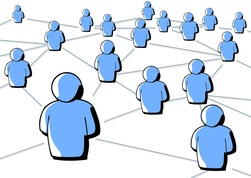
We differ widely in how much we tend to interact with others. Some of us are just more outgoing. I tend to chat with people I encounter during my day. Most are casual acquaintances; a few are strangers. Researchers Gillian Sandstrom and Elizabeth Dunn would classify these as “weak tie” interactions. Conversations with friends and family are “strong tie” interactions.
Why is this distinction between "strong ties" and "weak ties" important? We know that strong ties can result in feelings of belonging, help meet our need for belonging. What about weak ties? How is our well-being affected by interactions with a cashier, someone at the gym, another employee with whom we rarely work, and so forth?
In three creative studies Sandstrom and Dunn (2014) examined relationships between the number of daily weak tie interactions and self-reports of happiness and well-being. The participants in their studies were university students and community members older than 25. The more they interacted casually with those beyond their friends and family, the happier they reported to be.
- People with more weak tie interactions reported “greater feelings of belonging and greater happiness.”
- Feelings of belonging where greater on days when people had more weak tie interactions than usual.
- Both extroverts and introverts were happier the higher the number of weak tie interactions.
My take-aways:
1. As a consultant I found that where there were casual interactions among co-workers, the workplace climate was better. Conversely, where organizations limited casual conversations (such as no talking at the water cooler), climate was worse. In my opinion a small amount of time in social interaction reduced the time needed later if co-workers needed to interact on an issue. They already had a relationship of sorts. Phatic speech actually can lead to greater efficiency and effectiveness.
2. Given that there appears to be a relationship between weak ties and greater feelings of happiness, it would be interesting to see this studied in the workplace. There may be implications for managers and leaders. What activities or training may increase social interactions? What policies reduce casual interactions?
3. The comment about young adults underestimating the value of interacting with those they do not know well probably holds true for many people. Millennials may be more reluctant to interact with older workers but the reverse may also be true. My guess is that the more we can interact casually across our diversities, the more engaging and satisfying our workplaces will be.
Sandstrom, G. M., & Dunn, E. W. (2014). Social interactions and well-being: The surprising power of weak ties. Personality and Social Psychology Bulletin, 40(7), 910-922.
Image by Gerd Altmann.
Retrieved from: https://pixabay.com/en/social-media-personal-552411/
Public domain: https://creativecommons.org/publicdomain/zero/1.0/deed.en
© John Ballard, PhD, 2016. All rights reserved.
Author of Decoding the Workplace, BEST CAREER BOOK Next Generation Indie Book Awards.
_________________________
"Decoding the Workplace: 50 Keys to Understanding People in Organizations is as informed and informative a read as it is thoughtful and thought-provoking. . . Decoding the Workplace should be considered critically important reading for anyone working in a corporate environment." —Midwest Book Review
 RSS Feed
RSS Feed